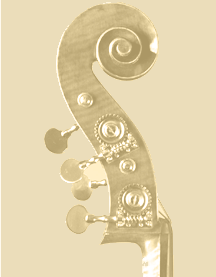Flat or Carved back upright bass?
What's better, a flat back or carved back
upright bass?
Why is the bass so unique that even to this present day, they are
made in both of these two styles? Historically, the present
style of the upright bass, evolved from the viol da Gamba.
(Henceforth, the reason why an upright bass can have a "gamba"
shape.) It has no violin corners. Even the Italians whom made
their first upright basses (in Brescia) had the violin form outline,
but still used flat backs. In subsequent years, the bass eventually
started to get carved backs (just like their violin and cello counterparts).
Even to this day, upright basses are made using gamba outlines,
with either carved or flat backs and there are violin form (outlines),
with violin corners, made still in either flat or carved back models.
Is there any shape or style that is better? There are some
musical (tonal) thoughts of why one might be better and there are
reasons of practicality. When compared to violin or even cello
making, carving a bass back is very strenuous and time consuming
work. Whenever basses are made whether on a private one per
order, or mass produced, basses with a carved back were always more
money. This is true today and true throughout history.
(Also, working and carving maple is much harder because it is much
denser wood.) Making a flat backed upright bass is much quicker
and cheaper.
Over time, carved back basses tend to show much less cracking.
With a carved back bass, the back is more "elastic" and
is able to accommodate the climate and seasonal changes much better
than a flat backed bass. Also, in flat back basses, the braces used
to support the back over time can peel away and actually shrink
or expand in different direction than the rest of the back.
This can sometimes be problematic. Some basses over time,
are more prone to this because the wood used for braces are too
temperamental with the seasonal change. Sometimes we just
change out the braces with new ( dry seasoned) wood and this usually
solves the whole issue.
Playing and sound. While there are no 2 basses the same, if one
were able to compare a flat back model to the very same
make (but a carved back), there might be a small difference in the
way the bass responds. The flat backed bass tends to respond
with a sharper, quicker attack, while the carved back bass will
still have good attack, but tend to also have a little more depth
to it. This of course is a huge generality! Both types
of basses work and can sound great, but they have to be set up and
treated according to individual requirements of that particular,
one bass and player.

 |
|


